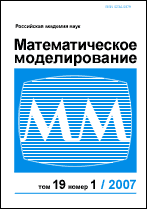|
This article is cited in 2 scientific papers (total in 2 papers)
A basic lattice model of excitable medium: kinetic Monte Carlo simulations
A. G. Makeev, N. L. Semendyaeva
Lomonosov Moscow State University
Abstract:
A simplest stochastic lattice model of an excitable medium is considered. Each lattice cell may be in one of the three states: excited, refractory and quiescent. The transitions between different cell states occur with prescribed probabilities. The model is intended for studying the transmission of excitation in the cardiac muscle or in the nerve fiber, as well as for studying epidemic spreading. Simulations of elementary events on a lattice are performed using Kinetic Monte Carlo simulations. In this way, a Markov chain of lattice states, which corresponds to the solution of the master equation, is generated. An effective algorithm for realization of Kinetic Monte Carlo simulations is suggested. At each time step of the algorithm the amount of arithmetic operations is practically independent on the lattice sizes; this allows performing simulations on the very large twoand three-dimensional lattices (above $10^9$ cells). It is shown that the model reproduces the main spatio-temporal patterns (solitary travelling pulses, pulse trains, concentric and spiral waves, “spiral turbulence”) typical for excitable media. The main properties of travelling pulses and spiral waves in the stochastic lattice model are investigated and they are compared with those known properties of deterministic equations of the reaction-diffusion type which are usually used to model excitable media.
Keywords:
excitable medium, travelling pulses, spiral waves, lattice models, Kinetic Monte Carlo simulations.
Received: 10.08.2015
Citation:
A. G. Makeev, N. L. Semendyaeva, “A basic lattice model of excitable medium: kinetic Monte Carlo simulations”, Mat. Model., 28:7 (2016), 3–19; Math. Models Comput. Simul., 9:5 (2017), 636–648
Linking options:
https://www.mathnet.ru/eng/mm3744 https://www.mathnet.ru/eng/mm/v28/i7/p3
|

| Statistics & downloads: |
| Abstract page: | 495 | | Full-text PDF : | 136 | | References: | 58 | | First page: | 7 |
|




 Contact us:
Contact us: Terms of Use
Terms of Use
 Registration to the website
Registration to the website Logotypes
Logotypes







 Citation in format
Citation in format 
